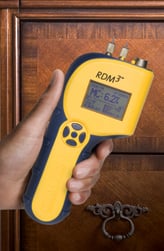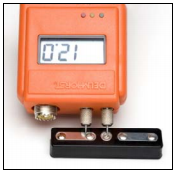 For professional woodworkers, contractors, farmers, restoration specialists and anyone else for whom monitoring the moisture content of what they’re working on is a factor, it is important to have an accurate, reliable moisture meter. But, how accurate is your moisture meter?
For professional woodworkers, contractors, farmers, restoration specialists and anyone else for whom monitoring the moisture content of what they’re working on is a factor, it is important to have an accurate, reliable moisture meter. But, how accurate is your moisture meter?
Verifying that your moisture meter is in calibration and not giving you inaccurate results is the cornerstone of being able to make correct decisions in dealing with your moisture-sensitive work. So to help you make sure that your meter is working right, we’ve assembled a list of ways that you can verify your moisture meter’s calibration:
#1: Get Your Meter from a Reputable Supplier
One of the first ways to make sure that your meter is accurate is to get a high-quality product from a trusted source. Before you buy from a manufacturer or store, check the meter maker’s credentials and ask the following questions:
- Do they verify the calibration of their meters before shipping them out?
- Can their testing methods be traced through a reputable, independent third-party group such as the NIST?
- How strongly does the manufacturer guarantee the quality of their work?
- What do other customers say about their products?
Odds are, if the manufacturer is reputable and makes a high-quality, accurate product, the answers to the above questions will be mostly favorable. It also helps if the manufacturer has been in business for a number of years, as that is a strong indication of experience in making moisture measuring products.
#2: Take Measurements with the Same Meter Multiple Times
As any first-year Science 101 student can tell you, one of the greatest tests of a process is whether or not results are repeatable. For a moisture meter, this means that if your meter is accurate, then you should be able to take a reading of a piece of wood twice, and get similar (if not identical) readings both times.
If you measure twice in the same spot, with either a pinless or a pin-type meter, your results should be relatively consistent.
#3: Remember to Correct for Specific Material Type and Temperature
 A common error that leads many to think that their meter is broken is the failure to make corrections for different types of material and their readings at different temperatures. While moisture meters should not be hugely affected by differences in common room temperatures, wide variations in the temperature of wood and hay will affect meter readings. When measuring material with wide temperature variations, it is important to refer to a temperature correction chart.
A common error that leads many to think that their meter is broken is the failure to make corrections for different types of material and their readings at different temperatures. While moisture meters should not be hugely affected by differences in common room temperatures, wide variations in the temperature of wood and hay will affect meter readings. When measuring material with wide temperature variations, it is important to refer to a temperature correction chart.
Also, different species of wood might give different %MC results from one another, even when their actual %MC is the same. This is because of factors such as how the unique physical properties of different materials changes their conductivity and specific gravity, even when compared to similar materials. For example, if you measured the moisture content of a piece of douglas fir using a pin meter, then did the same to a piece of redwood with the exact same moisture content, you would get different results from each. Delmhorst provides a species correction chart online for our woodworking moisture meters to make sure that you always know the proper correction for your meter. Delmhorst also offers models that have built-in species correction capabilities.
#4: Compare Measurements to a Different Meter
If you suspect that your moisture meter is no longer providing accurate measurements, and want to test it in the field right away, you can use a second meter for reference. Ideally, both meters should be the same make and model, as two different types of meter from two different manufacturers will have different inherent calibrations. However, if they are both accurate, then they should both provide a relatively close moisture content measurement after temperature and species adjustments, regardless of manufacturer.
For thermo-hygrometers, place both units within a few inches of each other simultaneously as you take your RH measurements. These have to be done at the same time and close to each other in order to minimize the chance of random environmental factors causing an inaccurate reading.
#5: Check the Contact/Scanning Element
Sometimes, when a meter begins giving incorrect readings, it’s because of damage to the pins (for pin-type meters) or contact plate (for pinless meters). Check the scanning element for signs of corrosion or contamination, such as rust.
For pin meters with damaged pins, restoring normal function can be as easy as attaching a new set of pins.
#6: Verify the Meter is Undamaged
If the internal components of a moisture meter become damaged, then the meter will start to give inaccurate readings. If your meter is giving you inaccurate readings, but the meter’s contact/scanning element is clean and undamaged, you might have damage to the PC board or other electrical components. Loose wiring, broken circuitry, and dampness in the interior of the unit can all cause a meter to lose its accuracy.
This can be difficult to check on your own without taking the meter apart (which we strongly recommend that you avoid). Signs of damage that you might be able to spot without having to take the unit apart include:
- A rattling noise coming from the meter as you handle it (indicating that something has broken loose inside the unit).
- Missing segments of numbers on an LCD screen, or a failure of the screen’s backlight on analog displays. This could be as minor an issue as a depleted battery, or as serious as compromised wiring. If replacing the battery doesn’t solve the problem, contact the manufacturer for advice.
It’s important to make sure that your meter comes from a company that offers great repair services for their products. Check with your meter’s manufacturer to see how much it would cost to send your meter in for repair, as it is usually cheaper than having to buy a whole new meter.
#7: Use a Purpose Built Testing Device
 Some moisture meter manufacturers offer a ready-made testing plate or other tool for making sure that their moisture meters are giving accurate readings. Testing boards and similar items are highly useful for checking the calibration of a moisture meter quickly and easily.
Some moisture meter manufacturers offer a ready-made testing plate or other tool for making sure that their moisture meters are giving accurate readings. Testing boards and similar items are highly useful for checking the calibration of a moisture meter quickly and easily.
For example, Delmhorst’s pin-type meters can be checked using a device called a Moisture Content Standard (MCS). This device, which is specific to Delmhorst’s meters, is a convenient device for checking the accuracy of the meter (assuming said meter doesn’t already have a built-in check).
#8: Get a Moisture Meter with Built-in Calibration Checks
Many of Delmhorst’s moisture meters come with built-in calibration checks to take the guesswork out of assessing whether or not your moisture meter is giving you accurate readings. Of all the methods here, using a meter that has a built-in calibration check is perhaps the easiest and most convenient way to know for sure if your meter is working right.
Be confident in your tools today by making sure that they are calibrated and ready for action.

Comments